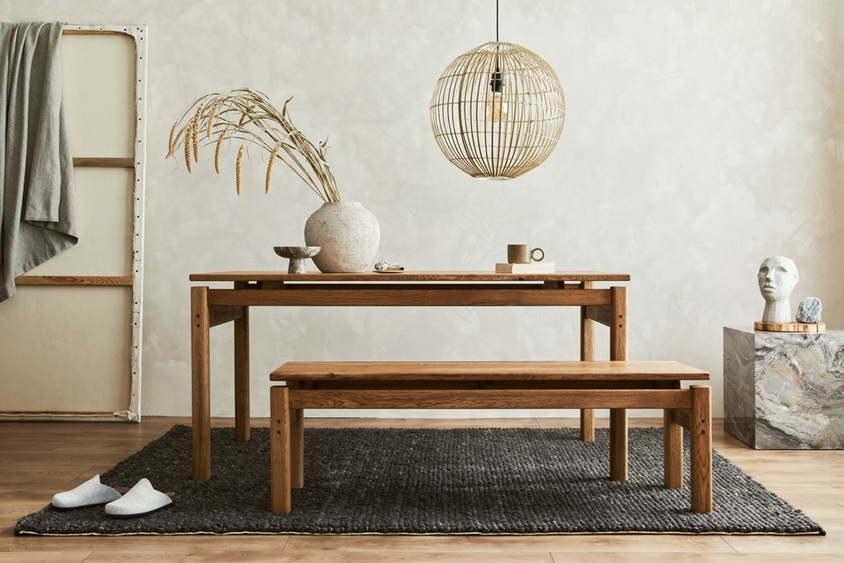At the Dining

Source: Home Lane
In the heart of the Wabi Sabi dining interior, a serene and profound beauty unfolds with every glance. The lime washes grey walls, gently textured and adorned with subtle imperfections, exude a sense of timeless elegance. Their muted hue provides a soothing backdrop that allows the other elements in the room to shine.
Beneath your feet, the unfinished parquet flooring adds depth and character to the space. Its raw, untreated surface speaks of authenticity and invites you to connect with the natural world. As you walk, you can feel the warmth of the wood beneath your soles, each creak and groan a testament to its history.
A charcoal woven rug rests gracefully beneath the weathered wood dining table and benches, softening the space while grounding it in earthy tones. Its intricate patterns evoke a sense of craftsmanship and artistry that complements the simplicity of Wabi Sabi design. On the dining table itself, a white pottery pot housing a lalang plant becomes the focal point. Its unassuming beauty celebrates the imperfections that make each piece of pottery unique. Handmade ceramic cups and mugs, each with its own irregularities, beckon you to savour your meals and drinks slowly, appreciating the artistry of the everyday.
Above the table, rattan lights cast gentle, dappled shadows, adding an ethereal quality to the ambiance. Their woven patterns echo the rug below, creating a harmonious interplay of textures and shapes. To the side, a marble stand stone cradles a molded human pottery face and a piece of marble cutout stone. The juxtaposition of the organic and the man-made invites contemplation, reminding you of the fleeting nature of existence.
In the corner of the room, a painted, fragile slim ladder leans gracefully. A piece of grey cloth, almost ethereal in its delicacy, hangs on top. It's as if the ladder stands ready to reach for the intangible, symbolising the pursuit of beauty and impermanence inherent in Wabi Sabi.
Every element in this Wabi Sabi dining interior whispers the same message: beauty in imperfection, serenity in simplicity, and a profound appreciation for the transience of life's moments. It's a space that invites you to slow down, to savour, and to find solace in the art of imperfection.
The appreciation of handmade, unique, and artisanal items is a key aspect of Wabi Sabi. If you have an artistic sensibility and enjoy collecting one-of-a-kind pieces, this style will resonate with you. In a world filled with mass-produced, cookie-cutter items, Wabi Sabi stands out as a style that celebrates individuality and authenticity. Homeowners looking for a departure from mainstream design trends may opt for this theme.
To achieve this Wabi Sabi theme, you will need to:
- Select Natural Materials: Use natural materials such as wood, stone, and clay for furniture, flooring, and decor. These materials should showcase their imperfections and age gracefully over time.
- Embrace Imperfections: Don't shy away from imperfections in your furniture and decor. Scratches, dents, and weathered surfaces add character and depth to the space.
- Neutral Colour Palette: Stick to a muted and neutral colour palette, including earthy tones like greys, beige, and muted greens. These colours create a calming and harmonious atmosphere.
- Minimalist Design: Keep the design simple and uncluttered. Avoid excessive decoration and opt for functional, essential pieces of furniture and decor.
- Handmade and Artisanal Items: Incorporate handmade, unique, and artisanal items in your dining area. Look for pottery, ceramics, and textiles that showcase craftsmanship and individuality.
- Natural Textures: Integrate natural textures like rough-hewn wood, unpolished stone, and woven fibres. These textures add warmth and authenticity to the space.
- Plants and Greenery: Include plants and greenery to bring the outdoors in. Potted plants or a vase of fresh, imperfectly arranged flowers can enhance the natural ambiance.
- Soft Lighting: Opt for soft, diffused lighting rather than harsh overhead lights. Consider using candles, paper lanterns, or low-wattage bulbs to create a cozy and intimate atmosphere.
- Furniture with Patina: Choose furniture pieces with a patina that tells a story of age and use. Vintage or antique furniture often works well in a Wabi Sabi interior.
- Openness to Change: Wabi Sabi acknowledges the impermanence of all things. Be open to the idea that your dining area will evolve and change over time and embrace these changes as part of its beauty.
Avoid:
- Excessive Ornamentation: Avoid overly ornate or decorative elements. Keep the design minimalistic and focused on essentials.
- High-Gloss Finishes: Shiny or high-gloss finishes are not in line with the muted, natural aesthetic of Wabi Sabi. Choose matte or low sheen finishes instead.
- Mass-Produced Items: Steer clear of mass-produced, perfect-looking items. Instead, seek out unique, handmade, or vintage pieces.
- Overly Bright Colours: Avoid bright and flashy colours. Stick to a subdued colour palette inspired by nature.
- Rigid Symmetry: Wabi Sabi design embraces asymmetry and irregularity. Avoid overly symmetrical arrangements and perfectly matched items.
- Disposable Items: The theme is about cherishing and keeping items for their intrinsic beauty and meaning. Avoid disposable or trendy items that lack longevity.
- Overly Structured Spaces: Wabi Sabi interiors should feel organic and relaxed. Avoid overly structured or rigid design layouts.
- Harsh Lighting: Avoid harsh, glaring lighting. Instead, opt for soft and diffused lighting that creates a warm and inviting atmosphere.